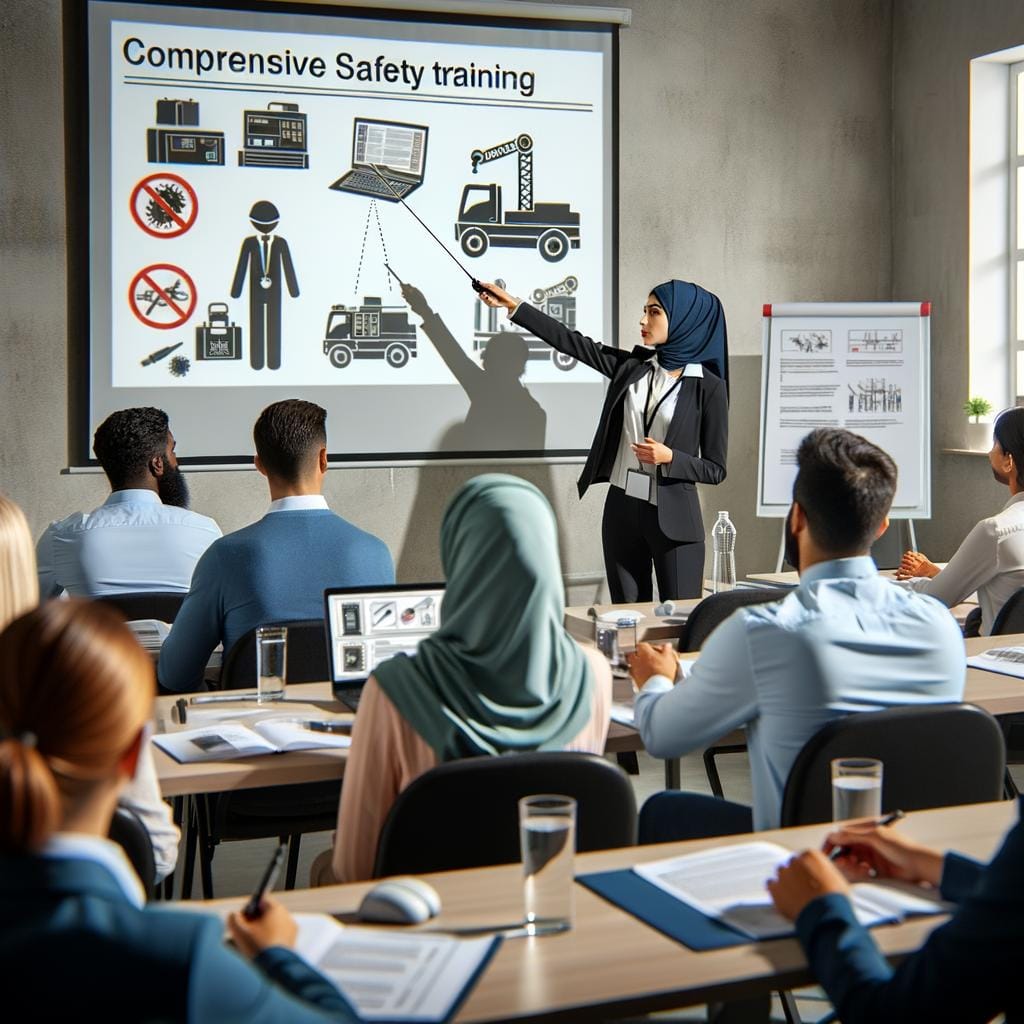Safety training is a crucial aspect of ensuring a safe and secure work environment for employees in any industry. By equipping workers with the necessary knowledge and skills to identify and mitigate workplace hazards, organizations can significantly reduce accidents, injuries, and even fatalities. Employers have a legal and ethical responsibility to provide adequate safety training to their employees to comply with Occupational Safety and Health Administration (OSHA) regulations.
Effective safety training not only protects employees from harm but also helps companies avoid costly fines and penalties for non-compliance with safety regulations. Through proper education and training, employees can learn how to assess risks, follow safety protocols, use protective equipment, and respond effectively in emergencies. Investing in safety training programs demonstrates an organization’s commitment to prioritizing the well-being of its workforce.
Moreover, implementing comprehensive safety training programs can lead to increased productivity, improved morale, reduced absenteeism, and enhanced overall job satisfaction among employees. Organizations that prioritize employee safety through regular training sessions create a culture of safety consciousness that permeates throughout the workplace. By promoting a safe work environment, companies can foster a more engaged and loyal workforce while minimizing potential risks associated with workplace accidents.
Overview of OSHA Regulations and Requirements for Safety Training
The Occupational Safety and Health Administration (OSHA) plays a crucial role in ensuring workplace safety by setting and enforcing standards to protect employees. OSHA regulations require employers to provide their workers with a safe and healthy work environment, including proper safety training. Compliance with these regulations is not only necessary for legal reasons but also essential for preventing accidents and injuries in the workplace.
OSHA Safety Training Requirements
OSHA regulations mandate that employers must provide safety training to employees on specific topics relevant to their job duties. This includes training on how to recognize workplace hazards, proper use of equipment and machinery, emergency procedures, and personal protective equipment (PPE) usage. Employers are also required to document the safety training sessions provided to employees and ensure that they are conducted by qualified trainers.
Importance of OSHA Compliance
Compliance with OSHA regulations is vital for maintaining a safe work environment and reducing the risk of accidents or incidents that could result in injuries or fatalities. By following OSHA guidelines for safety training, employers can create a culture of safety awareness among their employees, which can lead to fewer workplace accidents, improved morale, and increased productivity.
Failure to comply with OSHA regulations can result in penalties, fines, or even shutdowns for businesses, making it critical for organizations to prioritize safety training efforts.
Continuous Improvement
While meeting the minimum requirements set by OSHA is essential, companies should strive for continuous improvement in their safety training programs. Regularly updating training materials, incorporating feedback from employees, conducting refresher courses, and staying informed about new industry-specific hazards are all ways that organizations can enhance the effectiveness of their safety training programs.
By investing time and resources into ongoing safety training efforts, companies can create a safer work environment for their employees while also staying compliant with OSHA regulations.
Common Workplace Hazards That Safety Training Can Help Prevent
Workplace safety training plays a crucial role in preventing and mitigating various common hazards that employees may face in their work environment. By educating employees on these potential dangers and providing them with the necessary knowledge and skills to address them, employers can significantly reduce the risk of accidents, injuries, and even fatalities in the workplace.
Slips, Trips, and Falls
One of the most common workplace hazards that safety training can help prevent is slips, trips, and falls. These incidents can occur due to wet or slippery floors, uneven surfaces, cluttered walkways, inadequate lighting, or improper use of ladders. Safety training programs can teach employees how to identify potential hazards, maintain a clean and organized work environment, use proper footwear, and follow safe practices when working at heights to prevent such accidents.
Chemical Exposure
Another prevalent hazard in many workplaces is chemical exposure. Employees who work with hazardous substances need to be trained on how to handle, store, and dispose of chemicals safely. Safety training can provide information on the potential health risks associated with different chemicals, proper handling procedures, correct usage of personal protective equipment (PPE), and emergency response protocols in case of accidental exposure.
Machine Guarding and Equipment Safety
Improper use of machinery and equipment can also lead to serious injuries in the workplace. Safety training programs can educate employees on machine guarding requirements, equipment operation procedures, lockout/tagout protocols for energy sources control during maintenance or repair tasks, as well as the importance of regular inspections and maintenance checks.
By ensuring that employees are knowledgeable about how to operate machinery safely and follow proper safety protocols while using equipment, employers can reduce the risk of accidents caused by mechanical failures or human error.
Implementing comprehensive safety training programs that address these common workplace hazards is essential for maintaining a safe work environment for all employees. By providing employees with the necessary knowledge and skills to identify potential risks and take appropriate preventive measures, employers can create a culture of safety within their organization and minimize the likelihood of accidents or injuries occurring on the job.
Benefits of Implementing Safety Training Programs for Employees
Implementing safety training programs for employees is a crucial aspect of creating a safe and secure work environment. By providing comprehensive safety instruction, employers can reduce the risk of workplace accidents and injuries. Safety training equips employees with the knowledge and skills necessary to identify potential hazards, follow safety protocols, and respond effectively in emergency situations. This not only enhances employee well-being but also contributes to a more productive and efficient work environment.
One significant benefit of safety training programs is the reduction of workplace incidents and accidents. According to the Occupational Safety and Health Administration (OSHA), proper safety training can decrease the number of work-related injuries by up to 70%.
By investing in employee safety education, companies can minimize the financial burden associated with accidents, such as medical expenses, worker’s compensation claims, and possible legal fees. Additionally, a safer work environment boosts employee morale and retention rates, leading to increased productivity and overall company success.
Another advantage of implementing safety training programs is the compliance with OSHA regulations and other industry standards. OSHA mandates that employers provide a safe workplace for their employees, including adequate safety training on occupational hazards relevant to their job duties. Failure to comply with these regulations can result in costly fines and penalties. By ensuring all employees receive proper safety instruction, companies demonstrate their commitment to compliance and prioritize the well-being of their workforce.
| Key Benefit | Statistic/Information |
|---|---|
| Reduction of Workplace Incidents | Proper safety training can decrease work-related injuries by up to 70% (OSHA) |
| Compliance with Regulations | Failure to comply with OSHA regulations can result in costly fines for companies |
Types of Safety Training Programs Available for Different Industries
Safety training programs are crucial for ensuring the well-being of employees in various industries. Different sectors have unique risks and hazards that require specific safety measures to be put in place. Here is an overview of the types of safety training programs available for different industries:
- Construction Industry: In the construction industry, safety training programs focus on topics such as fall protection, scaffolding safety, electrical hazards, and equipment operation. These programs are essential in preventing accidents and injuries on construction sites.
- Healthcare Industry: Safety training in healthcare typically includes topics like patient handling techniques, infection control protocols, hazardous material handling, and emergency response procedures. Healthcare workers need to be trained on how to protect themselves and their patients from potential risks.
- Manufacturing Industry: Safety training programs for the manufacturing sector often cover machine guarding, lockout/tagout procedures, chemical safety, and proper use of personal protective equipment (PPE). Workers in manufacturing facilities face a variety of hazards that can be mitigated through comprehensive training.
In addition to these specific industry-focused programs, there are also general safety training courses that are applicable across all sectors. Topics such as fire safety, first aid/CPR, workplace ergonomics, and hazard communication are essential for all employees regardless of the industry they work in.
Overall, the goal of safety training programs is to equip employees with the knowledge and skills needed to identify potential dangers in their work environment and take appropriate measures to prevent accidents or injuries. By investing in comprehensive safety training programs tailored to their industry’s specific needs, companies can create safer workplaces for their employees while ensuring compliance with regulatory requirements.
How to Conduct Effective Safety Training Sessions for Employees
Safety training is a crucial aspect of ensuring a safe and secure workplace environment for employees. Conducting effective safety training sessions is essential in educating workers about potential hazards, preventive measures, and emergency procedures. One key element in conducting successful safety training sessions is to tailor the content to the specific needs and risks present in the particular industry or work environment.
When developing safety training programs, it is important to consider various learning styles and preferences of the employees. Utilizing a variety of teaching methods such as hands-on demonstrations, interactive workshops, visual aids, and group discussions can help engage participants and reinforce key safety concepts. Additionally, incorporating real-life scenarios and case studies relevant to the workplace can make safety training more relatable and impactful.
Furthermore, it’s essential to regularly assess the effectiveness of safety training programs by soliciting feedback from participants, conducting evaluations, and monitoring workplace incidents. Continuous improvement and updates to safety training content based on feedback and evolving industry standards are vital in maintaining a culture of safety awareness among employees. By investing in comprehensive safety training programs tailored to the specific needs of the workforce, organizations can create a safer work environment while promoting a culture of responsibility and accountability.
| Key Points | Details |
|---|---|
| Tailor Content | Customize training materials based on industry risks |
| Engage Participants | Use interactive methods like workshops and group discussions |
| Continuous Improvement | Regularly update training content based on feedback and incidents |
Case Studies
Implementing safety training programs in companies is crucial to ensuring the well-being of employees and complying with safety regulations. By examining case studies of successful implementation, it becomes evident how these programs can make a significant impact on workplace safety.
One notable case study is that of Company X, a manufacturing firm that prioritized safety training for its employees. By investing in comprehensive safety training programs tailored to various departments, Company X saw a significant decrease in workplace accidents and injuries. This not only improved the overall well-being of the workforce but also enhanced productivity and employee morale.
Another case study worth mentioning is that of Company Y, an engineering consulting firm that incorporated interactive safety training tools into their program. By utilizing advanced technology such as virtual reality simulations and online modules, Company Y was able to engage employees more effectively during training sessions. This innovative approach not only made safety training more engaging but also improved retention rates and overall compliance with safety protocols.
Interactive Safety Training Tools and Technology for Modern Workplaces
In today’s fast-paced and ever-evolving work environment, utilizing interactive safety training tools and technology has become essential in ensuring the safety and well-being of employees. These innovative resources not only engage workers in the learning process but also provide a more effective way to deliver important safety information. Here are some interactive safety training tools and technologies that modern workplaces can implement:
- Virtual Reality (VR) Training: VR technology allows employees to immerse themselves in realistic workplace scenarios where they can practice responding to potential hazards. This hands-on approach helps employees better understand safety protocols and procedures.
- Mobile Learning Apps: With the rise of smartphones and tablets, mobile learning apps have become a convenient way to deliver safety training to employees on-the-go. These apps can include interactive quizzes, videos, and simulations for a more engaging learning experience.
- Online Learning Platforms: Web-based learning platforms offer flexibility for employees to complete safety training modules at their own pace. These platforms often include multimedia elements such as videos, animations, and games to enhance learning retention.
Implementing these interactive safety training tools and technologies not only improves the effectiveness of safety training programs but also demonstrates a commitment to creating a safe work environment for all employees. By embracing new advancements in technology, companies can stay ahead of regulations and ensure that their workforce is well-equipped to handle any potential hazards that may arise.
Overall Benefits of Utilizing Interactive Safety Training Tools
- Increased engagement and retention of safety information
- Ability to simulate real-world scenarios for practical learning
- Convenience for employees with flexible access to training materials
- Cost-effective compared to traditional classroom-based training methods
- Improved compliance with regulatory requirements through consistent training delivery
By incorporating interactive safety training tools and technology into their workplace safety programs, employers can create a culture of safety awareness among their staff members while promoting a proactive approach towards preventing accidents or injuries on the job.
Conclusion
Safety training is an essential aspect of ensuring workplace safety and compliance with regulations. As discussed in this article, implementing effective safety training programs can help prevent common workplace hazards, promote a culture of safety among employees, and ultimately reduce the risk of accidents and injuries. By providing employees with the knowledge and skills needed to identify and address potential dangers in the workplace, organizations can create a safer work environment for everyone.
With OSHA regulations setting the standards for safety training requirements, it is crucial for companies to stay up-to-date with the latest guidelines and ensure that their training programs are compliant. Investing in safety training not only protects employees from harm but also helps organizations avoid costly penalties and liabilities resulting from non-compliance. From conducting regular safety audits to incorporating interactive training tools and technology, companies have a range of options available to enhance their safety training efforts.
The future of safety training lies in continuous improvement and innovation. As workplaces evolve and new technologies emerge, it is important for organizations to adapt their safety training programs to meet changing needs.
By prioritizing employee well-being and investing in comprehensive safety training initiatives, companies can create a safer, more productive work environment for all. In conclusion, safety training should be seen as a fundamental component of any successful business strategy, contributing not only to the well-being of employees but also to the overall success and sustainability of the organization.
Frequently Asked Questions
What Is the Safety Training?
Safety training is a crucial aspect of any workplace environment to ensure the well-being of employees. It involves educating individuals on best practices, procedures, and protocols to prevent accidents, injuries, or illnesses.
What Are the Three Types of Safety Training?
Three types of safety training include general safety training, specific safety training, and regulatory safety training. General safety training covers basic principles such as emergency procedures, hazard communication, and personal protective equipment.
Specific safety training focuses on particular tasks or equipment like forklift operation or chemical handling. Regulatory safety training pertains to compliance with laws and regulations set by organizations like OSHA.
What Is OSHA Safety Training?
OSHA safety training refers to programs developed by the Occupational Safety and Health Administration to promote safe working conditions for employees in the United States. This training covers various topics including workplace hazards, ergonomics, electrical safety, hazardous materials handling, and more. OSHA safety training aims to reduce workplace accidents and injuries through comprehensive education and enforcement of regulations.

An avid outdoor enthusiast, writer, and environmental advocate who has spent over two decades exploring the world’s most breathtaking landscapes. With a background in environmental science and a passion for adventure, Frances combines her love for nature with her talent for storytelling to inspire others to embark on their own outdoor journeys.





